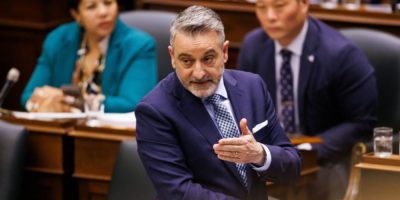
Ontario is staring down a teacher shortage as retirements and student enrolment are both on the rise, and the Ministry of Education expects the situation will start to get even worse in 2027.
The warning is contained in a series of briefing documents for the new minister of education, obtained by The Canadian Press through a freedom-of-information request.
Many school boards in Ontario and elsewhere are experiencing challenges recruiting and retaining enough qualified teachers, the document says, and in Ontario, the issue is particularly felt in areas such as French and tech education.
"Modelling projects that student enrolment over the coming years is expected to increase along with teacher retirements, while the supply of new teachers is to remain stable, absent intervention," the briefing says.
"These factors are projected to result in a growing gap between the number of teachers needed and the number of teachers available. This (projected) gap is expected to widen beginning in 2027."
Barrie's News Delivered To Your Inbox
By submitting this form, you are consenting to receive marketing emails from: Central Ontario Broadcasting, 431 Huronia Rd, Barrie, Ontario, CA, https://www.cobroadcasting.com. You can revoke your consent to receive emails at any time by using the SafeUnsubscribe® link, found at the bottom of every email. Emails are serviced by Constant Contact
Word of teacher supply and demand struggles is not new to the unions representing Ontario's teachers, who say one of the main issues is working conditions, including violence in classrooms, too few special education supports, and not enough money for classroom supplies.
"The conditions in the classroom are deteriorating," said Karen Brown, president of the Elementary Teachers' Federation of Ontario.
"We have members within their first five years just leaving the profession ... It's troubling that this government knows that there are some issues with retention and recruitment and that they're actually not wanting to address them."
A spokesperson for Education Minister Jill Dunlop said in a statement that the government has introduced a number of measures, including halving processing timelines for domestic and international applicants, allowing second-year teaching candidates to work as supply teachers, and replacing seniority-based hiring with a merit-based system for quicker recruitment of staff.
"School boards and education unions need to do their part by creating a serious plan to improve teacher absenteeism with better attendance management practices that ensure students are continually taught by qualified educators in the classrooms now and into the future," Edyta McKay wrote.
A decade ago, Ontario had a teacher surplus, with an unemployment rate of nearly 40 per cent for teachers in their first year after becoming certified.
In 2015, the then-Liberal government made teachers' college two years instead of one and admission rates plummeted from more than 7,600 in 2011 to 4,500 in 2021 – and now early-career unemployment is at "statistically negligible levels," according to the Ontario College of Teachers.
It may be time to review that program, said Karen Littlewood, president of the Ontario Secondary School Teachers' Federation.
"I'm sure they're filling the two years with lots of meaningful teaching and learning, but maybe we need to look at compacting it," she said.
The Ontario Teachers' Federation estimates that there are about 48,000 teachers who are certified but not currently working in the province's education system.
Brown said that number is telling.
"The working conditions are not conducive for these 40,000 people to say, 'Hey, I want to take this on,'" she said.
"We've negotiated some good contracts. We're doing well. So (teaching) is not something where you wouldn't be able to make a decent living, but it's the conditions."
The unions are also wondering why the troubling prediction that shortages will get worse in three years was not conveyed to them.
"I think some of the crisis and some of the shortage probably could have been avoided along the way, but, they have those numbers - I don't know why they aren't sharing them with us and why we aren't planning together," said Littlewood.
René Jansen in de Wal, president of the Ontario English Catholic Teachers' Association, said teacher shortages are not a future problem, but one that schools are already grappling with.
"That recruitment and retention issue is real," he said. "It's not a 2027 thing. It is a now thing, and it's a getting worse thing, which actually kind of makes it astounding that there's no evidence this government is doing anything substantive about it."
The briefing document says that in particular there is an "acute shortage" of French-as-a-second-language teachers in Ontario, "as in other provinces and territories." Demand is rising for French immersion and extended French programs, the document says.
French-language school boards are also desperate for teachers, said the union representing the teachers in that system. It ties back to the decision to extend teachers' college to two years, which was done primarily with English system needs in mind, said the Association des enseignantes et des enseignants franco-ontariens.
"Before, the number of graduates was barely sufficient to meet the needs of school boards and to ensure an adequate number of short-term substitute teachers," Gabrielle Lemieux wrote in a statement.
"By applying a solution aimed primarily at the majority system to everyone, the government disregarded its obligations toward the French-language education system. The shortage has only worsened year after year since this change."
The province and the federal government have put more than $23 million toward a French Teacher Recruitment and Retention Strategy since 2021-22, MacKay said, and it includes efforts to recruit more internationally trained French teachers.
The requirement to complete a two-year, "academic, not employment-based program and move from rural or remote areas" is also a barrier to getting more Indigenous teachers, the ministry briefing document says.
Demand for Indigenous language courses is rising, with eight per cent and 14 per cent increases in enrolment in elementary and secondary courses, respectively, between 2017-18 and 2019-20, the document says.
When it comes to tech teachers, the shortage has led the government to implement a rule allowing teachers with general qualifications to teach new, mandatory tech education courses.



